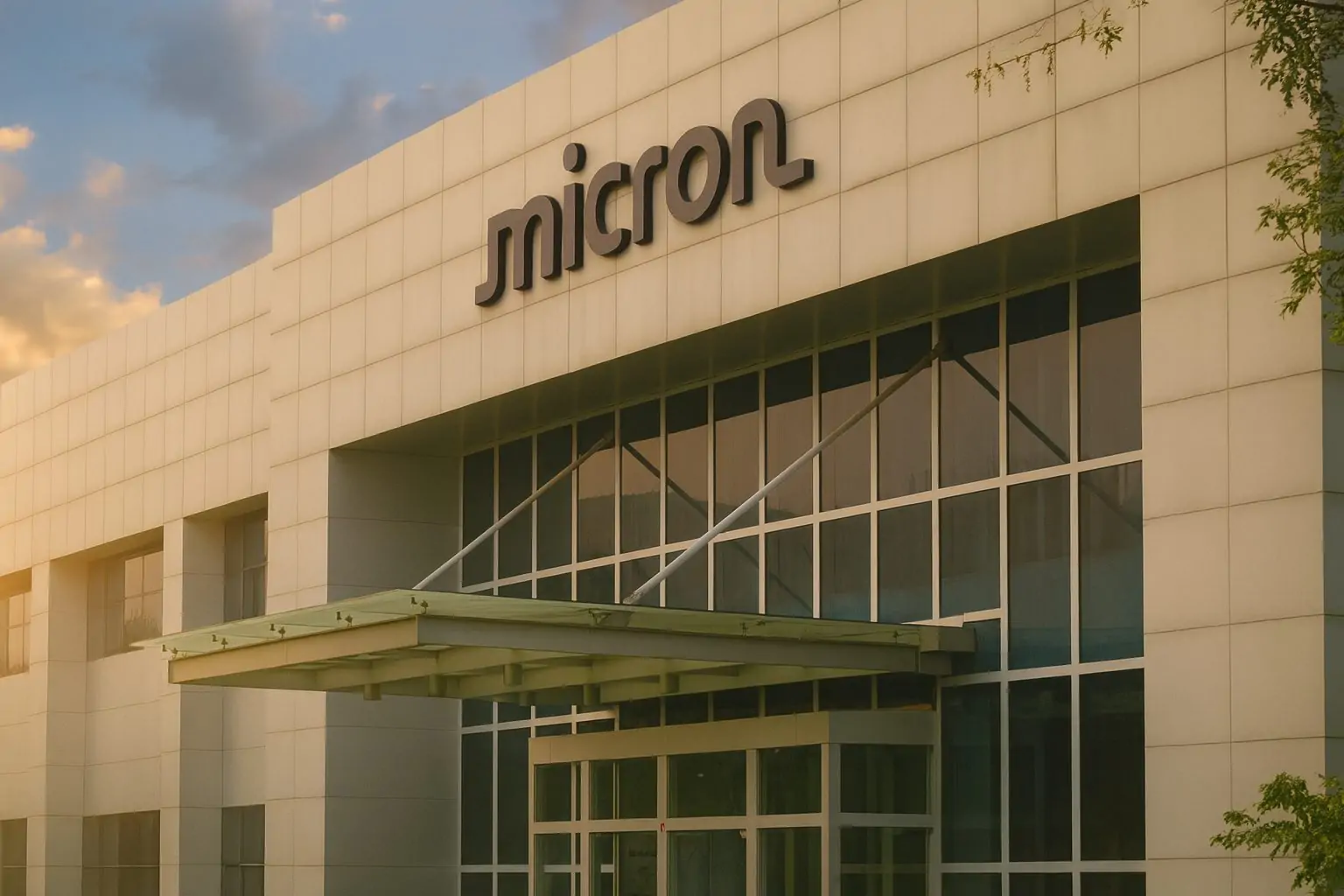Published: November 24, 2025 — Prices and data as of mid-day U.S. trading and subject to change.
Micron Technology (NASDAQ: MU) is back in rally mode today. As of mid-day on Monday, November 24, 2025, MU stock is trading around $224 per share, up roughly 8% on the session, a gain of about $16 from Friday’s close.
The move comes as Wall Street raises its expectations for Micron’s AI-driven memory business, highlighted by a fresh price target hike from Morgan Stanley, alongside a flood of bullish commentary on high‑bandwidth memory (HBM) demand and the AI data center cycle. [1]
MU stock price today (November 24, 2025)
- Last price (intraday): about $224.17
- Intraday move: roughly +8.1% vs. Friday’s close (about $207.37)
- Intraday range: low near $209.76, high around $224.25
- Volume: ~12–13 million shares traded so far, somewhat below the recent average near 23–24 million. [2]
Over the past year, Micron has been on a massive run:
- 12‑month low: about $61.54
- 12‑month high: around $260.58, reached earlier this month [3]
- Year‑to‑date performance: the stock has rocketed roughly 167% in 2025, driven by booming demand for AI‑oriented memory products and record financial results. [4]
Today’s bounce follows a sharp selloff last week, when Micron and other AI chip names slumped on concerns that AI enthusiasm had run ahead of fundamentals. [5]
Why MU stock is surging today
1. Morgan Stanley lifts its price target to $338
The clearest catalyst for today’s move: Morgan Stanley raised its price target on Micron from $325 to $338 and reiterated an “overweight” rating. [6]
According to the note, the new target implies over 50% upside from Micron’s recent share price, reflecting:
- Confidence in Micron’s earnings power as AI memory demand ramps
- Strength in high‑value data center products like HBM and server DRAM
- A still‑favorable valuation compared with other AI hardware plays [7]
Morgan Stanley is not alone. Other firms like Barclays, Mizuho and Cantor Fitzgerald have also been raising their price objectives in recent months, citing the same AI‑driven memory upcycle. [8]
Overall, MarketBeat data show five “Strong Buy,” 26 “Buy” and four “Hold” ratings on MU, with a consensus “Buy” and an average target price a bit above $210 (before today’s move). [9]
2. AI HBM demand upgrades and a reversal of last week’s selloff
Earlier this month, Micron’s shares briefly hit an all‑time high around $260 before pulling back more than 10% in a single day as investors worried that AI demand might cool after Nvidia flagged rising costs and slightly slower data center growth. [10]
But research from UBS and others has continued to raise global HBM demand forecasts through 2026, citing stronger‑than‑expected orders from Nvidia and AMD for next‑generation AI accelerators. [11]
A detailed analysis from 24/7 Wall St. argues that last week’s Micron selloff “never made sense,” pointing to: [12]
- Micron’s strong share in DRAM and NAND (roughly 23% and 12% of those markets, respectively)
- Rapid HBM growth, with the market expected to explode through the decade
- A forward P/E near 10, well below a semiconductor industry average closer to 25×, suggesting the stock could still be undervalued for its growth profile
Today’s rally looks like an overdue snap‑back as the market refocuses on fundamentals rather than short‑term AI sentiment.
3. Broader rebound in AI and growth stocks
U.S. index futures and major benchmarks are up today as investors bet that the Federal Reserve could start cutting rates in the coming months, giving growth and tech stocks a tailwind. [13]
Micron is benefiting from that risk‑on tone, especially as multiple outlets highlight the company as one of the top semiconductor and AI infrastructure names to own right now. Recent pieces from Motley Fool, Zacks, and others emphasize Micron as a leader in AI memory with long‑run earnings upside. [14]
Fundamentals: record fiscal 2025 and an AI data center boom
Today’s price spike rests on a very different Micron than the one investors saw just a few years ago.
Record results and margin expansion
Micron’s fiscal fourth quarter 2025 (reported in late September) capped a record year for the company: [15]
- Q4 revenue: about $11.3 billion, up in the mid‑40% range year over year
- Full‑year 2025 adjusted free cash flow: roughly $3.7 billion
- Capex: about $13.8 billion for the year, largely to expand advanced DRAM/HBM output
- Liquidity: around $11.9 billion in cash, marketable securities and restricted cash at year‑end
The company’s data center business has become the star:
- Data center revenue reached ~56% of total company sales in fiscal 2025
- Data center gross margin was about 52%, well above historical averages
- HBM revenue in Q4 approached $2 billion, implying an annualized run‑rate near $8 billion based on current demand for HBM3E products [16]
In other words, Micron is no longer just a cyclical PC and smartphone memory supplier — AI servers and cloud data centers are now the core of the business.
HBM and Nvidia partnership
Micron has leaned aggressively into high‑bandwidth memory (HBM), skipping the older HBM3 generation and focusing on HBM3E products tailored for cutting‑edge AI GPUs. Industry reports indicate Micron has been a key supplier of HBM3E for Nvidia’s H200 accelerators and is ramping 12‑stack HBM3E for the next wave of AI systems. [17]
At Nvidia’s GTC 2025 conference, Micron highlighted a broad AI portfolio spanning HBM3E, LPDDR5X server memory, GDDR7, and high‑capacity DDR5 modules, all aimed at high‑performance AI and data center workloads. [18]
On the roadmap, Micron is already sampling HBM4 with bandwidth above 2.8 TB/s and pin speeds over 11 Gbps, and planning HBM4E with customizable base dies in collaboration with TSMC. The company expects to sell out nearly all of its HBM supply for calendar 2026, supported by pricing agreements with a growing roster of six major customers. [19]
Management outlook: AI data centers as a multiyear boom
On its latest earnings call, Micron management emphasized that the AI data center build‑out is a multiyear cycle, not a short‑lived bubble, and that it expects sustained demand for advanced memory across hyperscale, enterprise and edge AI deployments. [20]
Independent analysis backs that view: recent research notes from hedge funds and independent analysts highlight Micron as arguably the leading HBM memory “pure play” and project that HBM could account for around 20% of Micron’s DRAM revenue by 2026. [21]
Analyst sentiment and valuation for MU stock
Street still broadly bullish
Beyond Morgan Stanley’s new $338 price target, Wall Street’s stance on Micron remains strongly positive: [22]
- A broad majority of analysts rate MU as “Buy” or “Strong Buy.”
- Several firms have recently raised their targets into the $200–$265 range as they update models for higher HBM and data center DRAM pricing.
Zacks has repeatedly featured Micron on lists of top growth stocks and compared it favorably to other chipmakers like Marvell in terms of earnings momentum and AI exposure. [23]
Is Micron stock still cheap?
Valuation is a big part of the bull case:
- MarketBeat data put Micron’s trailing P/E around 29×, with a price‑to‑earnings‑growth (PEG) ratio near 0.5, implying earnings are expected to grow much faster than the current price embeds. [24]
- Other analyses estimate Micron trades at roughly 10–13× forward earnings, depending on whether you look at 2025 or 2026 estimates — a discount to many high‑profile AI peers. [25]
- Some commentators argue that given Micron’s HBM leadership and AI leverage, the stock remains “undervalued” relative to its long‑term earnings power, even after a 160%+ year‑to‑date run. [26]
Of course, those views come from independent analysts and media outlets; investors should treat them as opinions, not guarantees.
Key risks for Micron stock investors
Despite today’s rally, Micron is not a risk‑free AI play. Important issues to watch include:
- Memory cyclicality
DRAM and NAND are historically cyclical markets. If AI demand slows or traditional end markets (PCs, smartphones) weaken, oversupply could pressure pricing and margins again, even for premium products. - Competition from SK Hynix, Samsung and China
SK Hynix currently leads the HBM market, and Samsung recently secured Nvidia qualification for its own HBM3E chips. Chinese memory makers are also pushing aggressively into DDR5 and other advanced nodes. [27] - Execution on capex and technology roadmaps
Micron is investing heavily — nearly $14 billion in capex last year — to scale its leading‑edge fabs and package advanced memory. If yields, ramp timing or customer qualification slip, returns on that investment could disappoint. [28] - Macro and policy risks
The AI boom is closely tied to hyperscale spending by a handful of tech giants. Any slowdown in cloud capex, changes in export controls, or shifts in CHIPS Act funding could impact Micron’s growth trajectory. [29]
What to watch next for MU stock
Investors tracking Micron stock over the coming weeks will likely focus on several catalysts:
- Next earnings report: Micron is expected to report fiscal Q1 2026 results (quarter ending November 2025) on December 17, 2025, after the close. [30]
- HBM capacity and pricing updates: Any color on 2026 HBM supply being fully sold out — and at what pricing — will be crucial for long‑term modeling. [31]
- AI server demand from Nvidia, AMD and others: Watch commentary from GPU vendors and cloud providers; their capex plans essentially set the ceiling for Micron’s AI‑related memory shipments. [32]
- Competition and technology milestones: Announcements around HBM4/HBM4E, LPDDR5/LPDDR6, GDDR7 ramps and any new customer wins could shift expectations for Micron’s share of the AI memory market. [33]
Bottom line on MU stock today
On November 24, 2025, Micron stock is climbing sharply, erasing part of last week’s pullback and reminding the market why it has been one of the hottest AI infrastructure plays of the year.
Today’s rally is being powered by:
- A new $338 price target from Morgan Stanley
- Ongoing upgrades to HBM demand forecasts and bullish AI data center commentary
- Record fiscal 2025 results, with data centers now more than half of revenue and HBM on an ~$8 billion annualized run rate
- A valuation that many analysts still view as reasonable for the growth on offer
Still, Micron sits at the crossroads of several volatile forces: cyclical memory markets, intense competition in HBM, and a macro backdrop that can shift quickly.
For investors, MU remains a high‑potential but high‑volatility AI infrastructure stock. Anyone considering a position should carefully weigh their risk tolerance and time horizon, and remember that past performance — including this year’s huge run — is no guarantee of future returns.
Disclaimer: This article is for informational and educational purposes only and does not constitute financial advice, investment recommendation, or an offer to buy or sell any security. Always do your own research and consider consulting a licensed financial professional before making investment decisions.
References
1. www.marketbeat.com, 2. www.marketbeat.com, 3. www.marketbeat.com, 4. finviz.com, 5. 247wallst.com, 6. www.marketbeat.com, 7. www.marketbeat.com, 8. www.marketbeat.com, 9. www.marketbeat.com, 10. 247wallst.com, 11. 247wallst.com, 12. 247wallst.com, 13. markets.financialcontent.com, 14. finviz.com, 15. investors.micron.com, 16. investors.micron.com, 17. www.nextplatform.com, 18. investors.micron.com, 19. investors.micron.com, 20. investors.micron.com, 21. beth-kindig.medium.com, 22. www.marketbeat.com, 23. finance.yahoo.com, 24. www.marketbeat.com, 25. finviz.com, 26. finviz.com, 27. seekingalpha.com, 28. investors.micron.com, 29. luckboxmagazine.com, 30. www.nasdaq.com, 31. investors.micron.com, 32. 247wallst.com, 33. investors.micron.com







